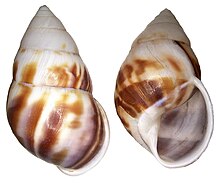|
Amphidromus perversus
Amphidromus perversus is a species of air-breathing land snail, a terrestrial pulmonate gastropod mollusc in the family Camaenidae.[1] Amphidromus perversus is the type species of the genus Amphidromus, by the subsequent designation of Eduard von Martens (1860).[2][3] SubspeciesThere are six subspecies of Amphidromus perversus:[3]
DistributionDistribution of Amphidromus perversus include Sumatra and Java to Borneo, Sulawesi and Bali.[3] Absent from the Mentawi Chain and Panaitan Island.[3] Its occurrence on Sumbawa needs confirmation.[3] Probably it has been introduced into Singapore.[3] Subspecies recognized here are from Great Natuna, Bawean, Kangean Islands and Riau Islands.[3] Shell descriptionAmphidromus perversus are amphidromine (left-handed and right-handed snails occur in the population).[3] In Amphidromus perversus and most other thick-shelled Amphidromus species, the lip is internally thickened, forms a "roll" in its expansion, and has a very heavy parietal callus.[3] The shell is solid, polished, amphidromine, moderately large (45–55 mm) high, usually with a dark varix. Lip and callus white; ground color white, orange, yellow, or yellowish-green. Many specimens with interrupted or continuous radial brownish streaks covering part or all of the whorls on the lower spire and body whorl.[3]
Amphidromus perversus undoubtedly offers the greatest array of discretely variable color combinations of any species of Amphidromus.[3]  Color variation of Amphidromus perversus perversus include 12 forms:[3]
Amphidromus perversus butoti Holotype: Zoological Museum in Amsterdam.[3] The type locality is Bajutan, Kangean Islands. Collected by Hoogerwerf on August 20, 1954.[3] Description: A brilliantly colored series of populations with highly polished shell surface. The general intensity of the coloration and the strong polish are the only features separating this race from the other subspecies.[3] Remarks: The problem of how to treat insular populations which show minor divergence from the main stocks is far from being satisfactorily settled. The intense coloration of the Kangean populations shows a minor difference from the main populations and Laidlaw & Solem (1961)[3] have recognized it with a subspecific name. For purposes of future reference, they selected as holotype a shell with a color pattern quite distinct from any which have been named. Thus, the name butoti can at least be used for the color variation if it is decided to include the Kangean populations in the nominate form of perversus. Besides the nominate color pattern of butoti, shells referable to the infraviridis, infrapictus, rufocinctus, sultanus and typical perversus pattern were seen on Kangean Island.[3] Paratypes: Specimens were seen from several localities on Kangean Island. The shells from Sepandjang are in Chicago Natural History Museum, no. 97808, in the Zoological Museum in Amsterdam, and in Butot; Djukung specimens are in the Zoological Museum in Amsterdam; and topotypes from Bajutan are in Chicago Natural History Museum, no. 97806, and in Butot and the Zoologisch Museum, Amsterdam, Some additional material from Kangean Island (USNM 468416, Paravicini!) was seen after the description had been written.[3] Amphidromus perversus emaciatusRange: Central and East Java, possibly Bali.[3] Remarks: The shell is white with rather numerous brown flammulations that become confluent on the base, elongate, and quite slender. Apparently it is a white derivative from the interruptus stock, which may have a definite geographic separation in Bali and Java. Material from Kedewan, East Java (Butot, Chicago Natural History Museum 72404) ranged from 43.5 to 48 mm in height.[3] Amphidromus perversus melanommaRange: Riau Archipelago near Singapore and possibly Perak and Biliton Island off Borneo.[3] Remarks: The purple apex, the numerous wavy brown flammulations that are partially interrupted by a yellow peripheral color band, and the solid shell are characteristic. This variety is similar to sultanus, but has only partial interruption of the stripes by the color band and has the purple apex. The Biliton record from the early Samarang voyage is questionable, and it is quite possible that the Perak records of De Morgan are in error. The only certain localities are the Singapore area and Riau Archipelago.[3] Amphidromus perversus natunensis Range: Great Natuna Islands; possibly the South Natuna and Anamba Islands also.[3] The yellow peripheral band of melanomma is absent; otherwise this is close to the Riau population. Amphidromus perversus natunensis is quite variable in color, ranging from white to dark (see Pilsbry 1900, pp. 162–163). Possibly some of the material that Jacobi (1895) dissected under the names Amphidromus interruptus and Amphidromus chloris belongs here, but the shells were not figured and their location is unknown. The South Natuna Island record needs confirmation, while specimens from Siantan, Anamba Islands (CNHM 72427), are referred by Laidlaw & Solem (1961)[3] with some hesitation.[3] Amphidromus perversus rufocinctusRange: Bawean Island, Java.[3] This weakly characterized race differs primarily by its intense color, strong color zone, and slight white margin at the suture. Of seventeen shells collected in May, 1954, by Hoogerwerf at Telaga Kastoba, Bawean Island, ten were dextral and seven sinistral. Three lacked a varix, one was grass green in color, three were whitish, and thirteen had yellow ground color. The name sankapurus Fruhstorfer, 1905, refers to white shells with a very dark color band. This variation is similar to Amphidromus perversus butoti.[3] ReferencesThis article incorporates public domain text from the reference [3]
External links
|
||||||||||||||||||||||||||||||||||||



